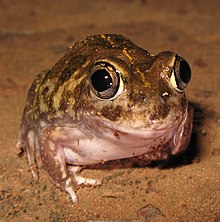Sudell's frog
It has been suggested that Trilling frog be merged into this article. (Discuss) Proposed since December 2019. |
| Sudell's frog | |
|---|---|

| |
| Scientific classification | |
| Domain: | Eukaryota |
| Kingdom: | Animalia |
| Phylum: | Chordata |
| Class: | Amphibia |
| Order: | Anura |
| Family: | Limnodynastidae |
| Genus: | Neobatrachus |
| Species: | N. sudelli
|
| Binomial name | |
| Neobatrachus sudelli (Lamb, 1911)[1]
| |

| |
| Range of the Sudell's Frog | |
The Sudell's frog or painted burrowing frog (Neobatrachus sudelli) is a species of burrowing frog common to a large part of southeastern Australia. It is found on and west of the Great Dividing Range of New South Wales to western Victoria and southern Queensland as well as far eastern South Australia.
Taxonomy
First described in 1911 by Joseph Lamb (born 1869), the author assigning the name Heleioporus sudelli. The specific epithet honours "Miss J. Sudell", who collected the type specimen near Warwick in Queensland.[1]
Description

The Sudell's frog is relatively small, reaching only 40 mm in length. It is highly variable and is generally brown, however it may also be grey, yellow or reddish on the dorsal surface with irregular darker spots or blotches. There is often a pale mid-dorsal stripe running down the back. The belly is smooth and pale cream or white. The toes are fully webbed, however a deep indentation is present between the webbing of each toe. The metatarsal tubercles (a shovel like structure on the foot to assist with burrowing) are completely black. The pupil is vertical and iris is silver.
Ecology and behaviour
Sudell's frog inhabits ponds, dams, ditches, clay pans or any still water in woodland, shrubland, and disturbed areas (including farmland). Males make a short trilling sound while floating in water after heavy rains, which flood the breeding area, from late winter through to autumn. The species is an adapted burrower and will often spend periods of time underground to avoid drought conditions.
About 600 eggs are laid in a clump entwined among vegetation near the surface, however will sink if disturbed. Hatching occurs about 3 days after laying and tadpoles are plump and large reaching about 77 mm (at about stage 40). The tadpoles often overwinter and metamorphs measure from about 20 to 30mm in length.
Similar species
It is similar to other species of Neobatrachus, particularly the painted burrowing frog (Neobatrachus pictus), from which it can be distinguished by baggy skin around the groin not being present in N. pictus. It is also similar to the ornate burrowing frog (Platyplectrum ornatum) and Heleioporus from which it can be distinguished by a fully black metatarsal, webbed toes and vertical pupil.
As a pet
It is kept as a pet,[2] in Australia this animal may be kept in captivity with the appropriate permit.
References
- ^ a b Lamb, J. (1911). "Description of three new batrachians from southern Queensland". Annals of the Queensland Museum. 10: 26–28.
- ^ Mark Davidson. 2005. Australian Reptile Keeper Publications. ISBN 0-9758200-0-1
- Anstis, M. 2002. Tadpoles of South-eastern Australia. Reed New Holland: Sydney. ISBN 1-876334-63-0
- Robinson, M. 2002. A Field Guide to Frogs of Australia. Australian Museum/Reed New Holland: Sydney. ISBN 1-876334-83-5

